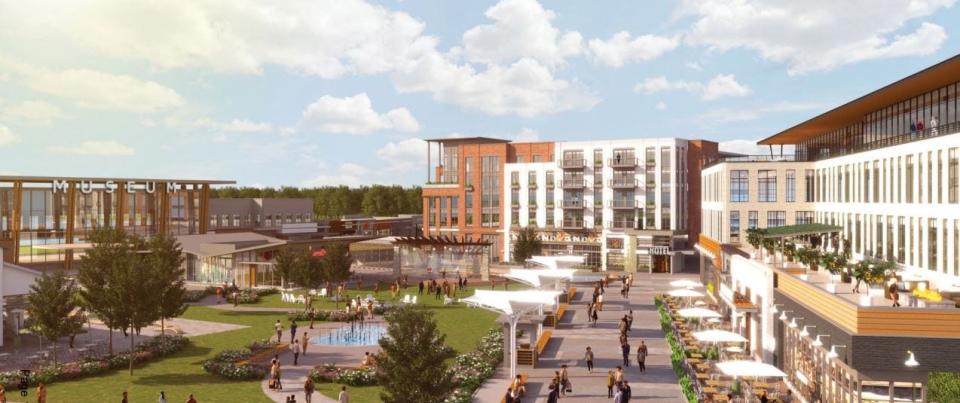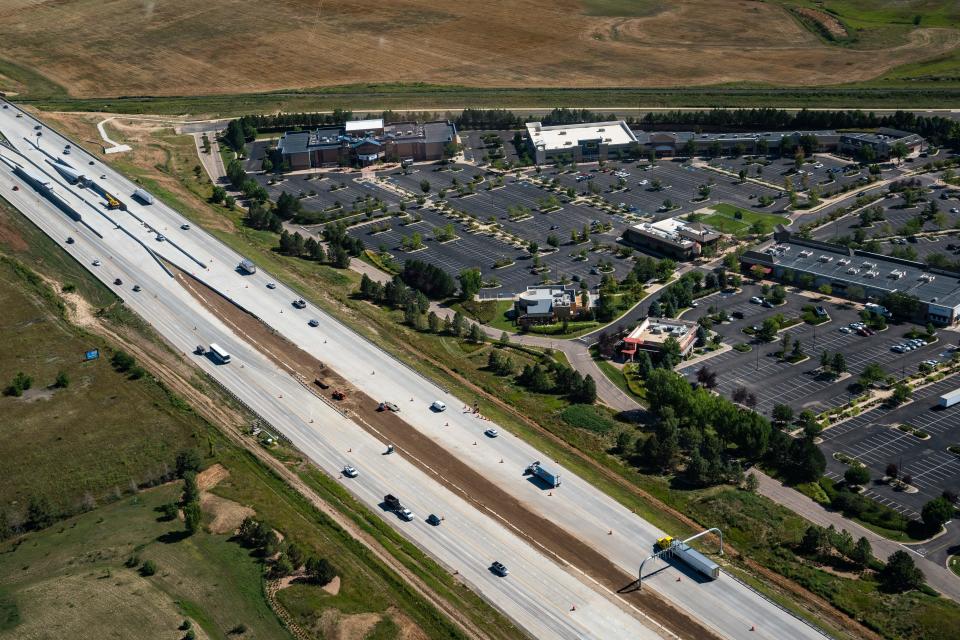Loveland voters will decide who has final say over urban renewal projects in 2023 election
Loveland voters will decide on Nov. 7 who should have final authority over proposed or changed projects that are governed by the city's Urban Renewal Authority: voters or City Council.
Here's the ballot language for Question 301:
"Shall Article 15 of the Loveland City Charter be amended to add Section 15-9 to provide that any council action approving or modifying an urban renewal plan, pursuant to Urban Renewal Law of state statutes, must be subsequently ratified by the registered electors of the city if the approval or modification of the urban renewal plan authorizes the use of or a change to area boundaries, eminent domain, condemnation, tax increment financing, revenue sharing, or cost sharing, and shall such amendment become effective immediately upon the date of approval by the city’s voters?"
A "yes" vote would amend the city charter to require voter approval of plans in urban renewal areas.
A "no" vote would keep the decisions in the hands of the Loveland URA board and City Council.
Currently, the 13-member Loveland URA board (comprised of city council members plus four representatives from taxing districts within the city) reviews projects or major amendments proposed within Urban Renewal Authority boundaries. If approved, the decision goes to City Council, where it could conceivably be overturned, but most likely would be rubber-stamped by the same council majority that approved it at the LURA level.

While the ballot language does not mention McWhinney Real Estate Services, Inc., the developer of the 3,000-acre Centerra master-planned community and the proposed $1 billion Centerra South development, the effort came about shortly after the URA board approved a new tax-increment sharing agreement for Centerra South, a 139-acre project that would push Centerra's boundaries to the south and include housing, retail, a children's museum and commercial projects.
The Loveland URA voted 9-4 Oct. 10 to approve a major amendment to the Centerra South plan after ratifying a tax-sharing agreement with Larimer County. City Council will vote on it Oct. 17. If council approves the plan, it will mean no matter what voters decide on Nov. 7, it won't affect Centerra South.
Robert McKnight, one of the founders of LetUsVoteURA23, the group that organized the petition drive for Question 301, said the issue isn't directed at McWhinney at all, but at council. "There were tax issues; we weren't sure the council had done its financial due diligence on (regarding) whether McWhinney needed any tax incentive money from the government."
The measure "gives us control over city council decisions to give away our tax dollars," McKnight said.

Citizen group concerns center on 'huge diversion' of funds from city's budget
A main concern about the URA in Loveland is the "huge diversion" of tax increment financing that will go to help develop infrastructure in a specific area of town, namely the U.S. Highway 34/Interstate 25 corridor, said George Garklavs, who helped gather signatures to get the question on the ballot.
Tax-increment financing, or TIF, is a development tool that allows the URA to use additional property tax revenue generated by planned improvements to a property to help pay for related public infrastructure improvements.
For example: As undeveloped land, the Centerra South property would generate $118,000 in property taxes over 25 years, or about $4,720 a year, according to a financial analysis by Andy Arnold of Pioneer Development Group, a consultant hired by the city.
Once it is fully developed, Centerra South would generate an estimated $272.3 million in sales and property taxes, according to city estimates. A URA board is allowed to divert some or all of that additional revenue back to the project for public infrastructure such as streets, curbs and gutters, water, wastewater and stormwater, etc.
Loveland's current agreement provides that 100% of the property tax increment revenue generated within the Centerra South Urban Renewal Area by the city’s current mill levy is retained by the Loveland Urban Renewal Authority. As of Oct. 3, LURA entered into tax increment revenue sharing agreements with all of the impacted taxing entities, except Larimer County, which objected to agricultural land being targeted as blighted.
Larimer County commissioners voted 2-1 on Oct. 10 to share 65% of its tax increment with the Loveland URA. The county will retain 35% of the property tax increment.
URAs generally expire after 20 to 25 years, which means the taxing districts get the full property and sales tax after the URA expires.
It's been said that TIF brings in more than enough money to pay for the diversion of tax revenue, Garklavs said. "But I've never seen a ledger that shows this, in fact, is happening. You hear comments that there is more than enough there but there's never any documentation, so it leaves you to wonder if it is a feel-good thing that we should be happy it's happening," he said. "Without seeing the numbers it's hard to believe. Having looked at the pros/cons of TIF, anything that diverts taxes from the general fund for 25 years, one of several things can happen: a decrease in services or taxpayers have to make up that difference."
Garklavs said it was never the group's intent to single out one developer. "It would apply to any developer that would use TIF within the city," he said. "It doesn't matter if it's developer A, B, C or D. The whole petition was directed more to City Council and related to citizens having input."
Group supporting URA worries yes vote would stall progress
Alyssa Wells, spokesperson for Protect Loveland's Future, an issue committee encouraging a "no" vote on Ballot Question 301, said: “We really want to ensure that Loveland voters understand what the passage ... would mean for Loveland’s future,” she said. “Question 301 would be detrimental to housing affordability in Loveland."
The urban renewal process is already complex, with statewide policies in place to ensure that any public-private agreements are "well-informed and fair to all involved entities," she said. "The Loveland Urban Renewal Authority board works fairly and transparently, allowing public input every step of the way."
Since the URA board is comprised primarily of officials elected to make decisions on the public's behalf, "we see no reason to single out URAs for a special election," Wells said. The URA process would be more expensive, take more time and be more cumbersome, she said, "without necessarily better outcomes than we have in the current system."
Protect Loveland's Future said "it's bad practice to base new policy on a single case. This initiative grew out of a small group's opposition to one URA plan."
Loveland City Council established the Loveland URA in 2002 to focus primarily on revitalizing downtown Loveland. The board was originally comprised solely of City Council members but a state law passed in 2015 required municipalities to expand the URA board to include representation from any tax districts within municipal boundaries, such as schools, fire and library districts, to ensure they had a voice in decisions that diverted tax dollars from their organizations.
The LURA hadn't had any projects come before it since the 2015 law passed so it hadn't expanded its board. But when McWhinney proposed Centerra South earlier this year, the LURA board had to expand to meet state statute. Today, the LURA board includes City Council members, Larimer County Commissioner Jody Shadduck-McNally and representatives from Thompson school board, Thompson Valley Health Services District and an at-large member from the community.
Each special taxing district is compelled to negotiate with the URA over how much of its tax revenue is diverted to the URA project, according to state law.
Shadduck-McNally said she is concerned about the statewide URA laws, transparency and accountability. Since Loveland council members make up a majority of the LURA board, "I want to make sure (the county) is a valued partner" and not just a token voice that helps the board meet state statutes, Shadduck-McNally said. "This is nothing about a specific project or person ... it's about the appropriate use of the URA tool when it comes to diverting property tax dollars and residents' property taxes and revenue."
The way the law is written, the county "doesn't have as much leverage when it comes to taxpayer money, which is a concern for me," she said. State law requires taxing entities to negotiate in good faith with urban renewal authorities, county attorney Bill Ressue told commissioners on Oct. 10. "It's not a question of whether the county will share, but how much." If the county and URA couldn't come to an agreement, the law requires binding mediation.
Having a mediator possibly decide how much of Larimer County's tax revenue would go to the URA created too much uncertainty, said Shadduck-McNally, who voted against the tax increment agreement at the Board of County Commissioner and LURA levels. "I believe leaving it to an arbitrator wouldn't be in our best interest financially."
Loveland City Council member Dana Foley, who chairs the LURA board, said he is unsure if Question 301 is legally enforceable. "I don't think we would have the authority to execute it," he said. If the question passes it will likely face a court challenge to determine its legality, he said.
The city currently has three urban renewal areas: U.S. 34/Crossroads Corridor, Block 41-expanded Finley's Addition and Centerra South, approved in May. The Downtown Loveland URA, adopted in 2002, expired and dissolved in April.
If Question 301 passes, McWhinney Senior Vice President of Community Development Kyle Harris said the company would try to work within the new framework.
"Our concern is if (a project) goes to a vote of electorate every time, it becomes a far more cumbersome process and may result in a URA not passing and development opportunity not occurring and the overall community suffering as a result," Harris said.
"The community needs to take a step back and look at the intent of the URA to begin with," he said. "The intent is to provide a financial tool, a mechanism that promotes economic development in areas that are otherwise very difficult to develop."
Garklavs acknowledges URAs and the use of tax-increment financing can have positive effects, but developers and the city will have to make their case to voters if Question 301 passes. "It gives citizens a voice in the process," he said.
If voters ultimately say they don't want a URA, "a necessary revenue stream is no longer available to help defray in part, the cost of very expensive public infrastructure that is necessary to create the very thoughtful communities" that McWhinney strives to create, Harris said. "Growth will continue to come to Northern Colorado. The question the city needs to wrestle with is what do they want that growth to look like?
If voters reject a URA "the tool is no longer available, the things that make these communities so special are no longer feasible," Harris said. "As a community, I don't know that the tradeoff is fully understood. Will these areas get developed in some way? Most likely yes, but without the benefit of that financial tool, we would argue they will be developed in ways to a far lesser benefit to the community. We've all seen areas of development where the bare minimum was done. That's not the type of development we want to do."
This article originally appeared on Fort Collins Coloradoan: Loveland voters to decide who has final say on urban renewal projects

